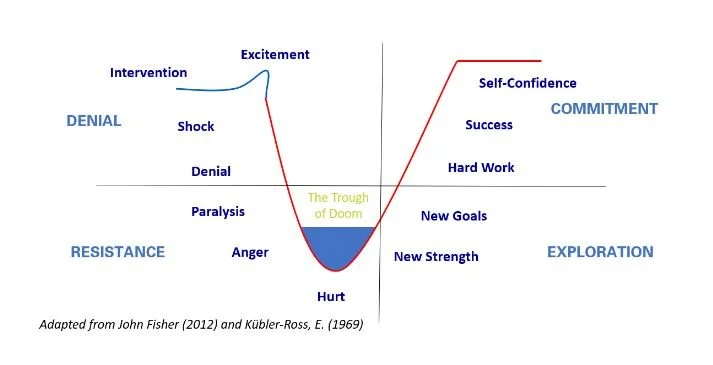Supporting our Team During Times of Change
Understanding how our team’s emotions and behaviours are affected by change
Winston Churchill once quipped that there were only two certainties in life: death and taxes. Well, it's time to add another certainty: Change. It affects every aspect of our lives. No company or individual is immune, whether it's a trusted colleague leaving, an organisational restructure, the implementation of a new system, or a complete relocation.
How does the Change Curve model help us navigate this?
If you've managed a team through a transitional period, you'll know how essential it is to understand the emotional rollercoaster that often accompanies change. One model that illuminates this is the Change Curve, (see below).
Change: The Inevitable Curve of Life and Work
What can a real-life story teach us?
Take the story of my friend, Mandy. When her partner was unexpectedly laid off, they navigated a whole host of emotions. From the initial SHOCK to DENIAL, then sinking into PARALYSIS and DEPRESSION, the journey was far from linear. It wasn't until he mustered NEW STRENGTH to set NEW GOALS that the tide began to turn. After much HARD WORK, he secured a new job, experiencing SUCCESS and a boost in SELF-CONFIDENCE.
Is the curve a straight path?
No! We don't progress neatly through these stages - we go forward and back. Factors like personality, prior experiences, and external life circumstances can accelerate or slow down the progression.
Understanding the emotional landscape of change isn't just good practice; it's an essential leadership skill. So, where do you think you or your team are on the Change Curve right now?
What's next?
So how can we identify where your team is on the Change Curve and how you can tailor your approach to support them through it effectively.
Supporting your team through the change curve
Why the Change Curve Matters for Managers
Why do some teams thrive during change while others flounder? The key lies in understanding the psychological journey that people go through during transitions. As you’ll be aware, different people go through these stages at different rates.
How can we Navigate the Stages of the Change Curve?
🔵 Denial: When change first happens, your team may be in shock or denial. What can you do to support them? Empathise (you don’t have to agree). Create a safe space where people can voice their concerns. Share facts clearly and listen actively. What might some of the ultimate benefits be?
🟠 Resistance: As reality sets in, resistance often follows. Anger, frustration, and worry dominate. Acknowledge the emotional toll. Openly ask, "What challenges do you foresee with this change, and how can we address them together?"
🟢 Exploration: In time, different people in the team will begin to explore what the change means for them. What could help them adjust? What resources or support can you set up? What would they like more of / less of from you? Encourage creativity and solutions-oriented thinking.
🔴 Commitment: The final stage is acceptance and commitment. How can you cement and celebrate this newfound stability? How can you use some people’s commitment to help bring other team members along?
Through this we foster a culture of resilience, engagement, and proactive problem-solving.
If you’d like to discuss how leadership coaching, leadership training, or team coaching can support your colleagues to lead change confidently feel free to get in touch for an initial conversation.
Kate Jennings


